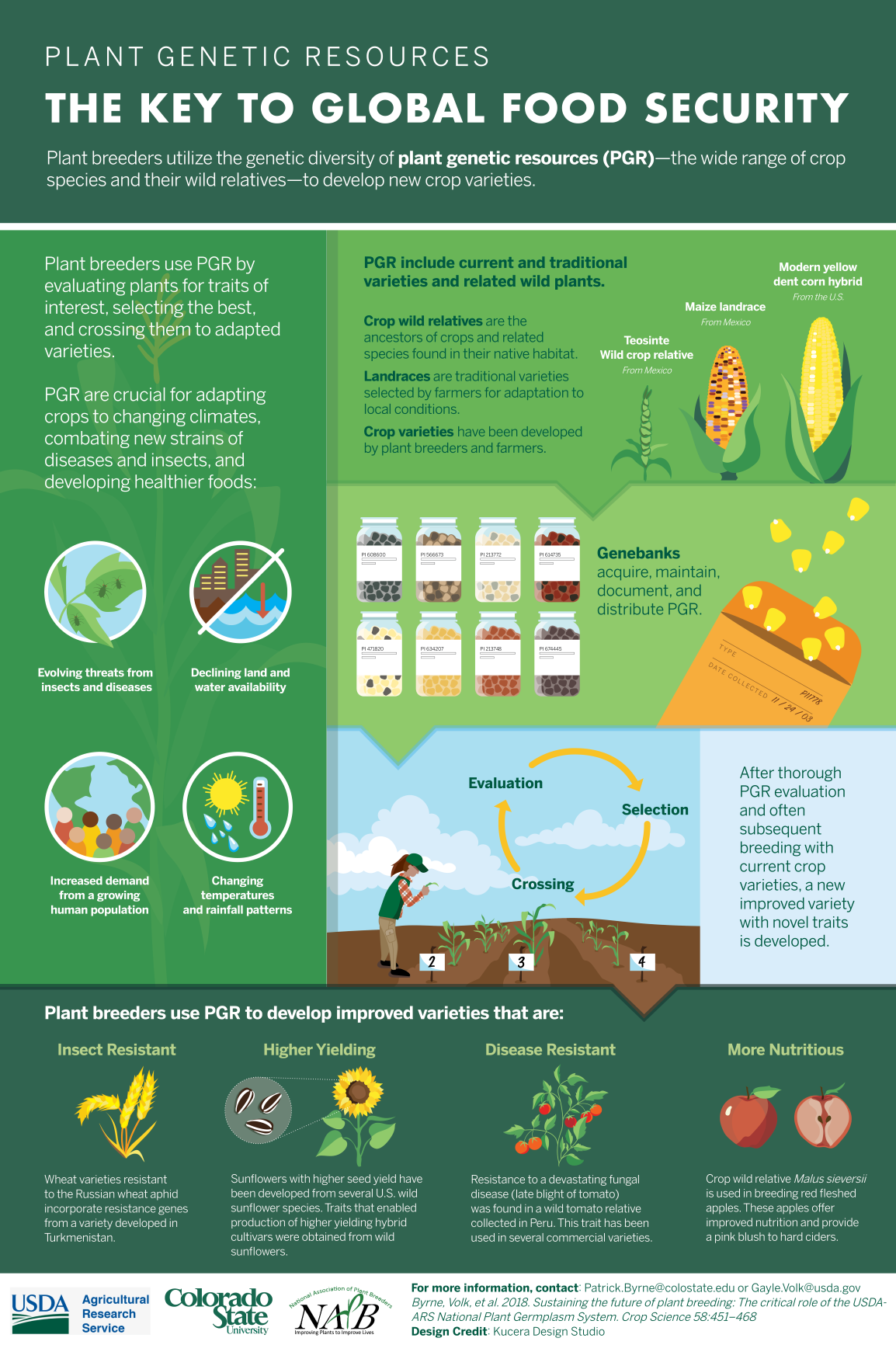Colorado State University, Iowa State University, and USDA to create a collection of germplasm trainings.
Colorado State University’s Department of Soil and Crop Sciences and Iowa State University’s Department of Agronomy, in conjunction with USDA’s National Plant Germplasm System, have jointly received a $750,000 grant from the USDA National Institute of Food and Agriculture. The grant, which consists of three years funding, aims to build an online repository of teaching and training materials.
“This project will continue to expand the knowledge and understanding of the importance of germplasm for crop improvement,” stated Dr. Patrick Byrne, professor of Plant Breeding and Genetics at Colorado State University, “The people that we’re targeting with this project could be future employees of the USDA system, future plant breeders that want to use germplasm in their breeding programs, and the general public that should be aware of USDA efforts in this area.”
Some of the materials that will be created will funnel into collegiate programs throughout the world, but others will be directed to a broader audience that lack some fundamental knowledge of germplasm. Dr. Byrne and Dr. Gayle Volk, research scientist with the USDA-ARS have created infographics to educate the general public on the significance of plant genetics and germplasm, and more specifically how those genetics apply to global food security.
Another product of this project will be training materials to educate individuals on how to translate information from a germplasm bank for use in a plant breeding program. For example, if a new disease arises in a crop, these materials can give guidance into the best strategies for evaluating a germplasm collection for resistance. Going a step further, if plant breeders were to identify a germplasm bank material that was resistant to a specific disease, these training resources would shed light on the best practices for crossing and incorporating the resistance into a breeding population.
A related grant from the Colorado State University Provost’s Office will fund production of a video that features the USDA germplasm bank on the Colorado State University campus in Fort Collins, Colorado. Before coronavirus, the germplasm bank, which is the only one of its kind in the United States for long-term germplasm storage, was overwhelmed with tour requests. Due to staff limitations, the bank was unable to accommodate all these requests. “This virtual tour is going to emulate the experience of actually going through the facility - entering the seed vaults, observing the cryo-preservation tanks, and hearing from the scientists who work there.” Dr. Byrne said.
The USDA-NIFA grant will also fund training information on pre-breeding. Pre-breeding, in a nutshell, is an intermediate step between germplasm collections and new plant varieties. “With many germplasm bank materials, especially wild species, you can't just start crossing with current cultivars,” Dr. Byrne said. “You would need to take those wild materials, make crosses with a compatible crop material, do some initial selection to make those lines resemble modern cultivars, then cross with an elite cultivar and complete selection of the new variety.”
This in-depth process means that a middle step, i.e. pre-breeding, is necessary.
“[Pre-breeding] is something that has been largely missing in the progression from germplasm bank to finished product. We would like to provide more information about pre-breeding to encourage more efforts in that area.”
Dr. Maria Munoz-Amatriain, professor of genetics and plant breeding at Colorado State University, will be creating three online graduate-level courses related to germplasm issues as part of the grant. These courses will incorporate digital learning resources that are developed by both Colorado State University and Iowa State University.
“For many traits of interest to breeders, evaluation in the field will be necessary.” Dr. Byrne started. “This is a daunting task, given the hundreds or thousands of accessions of a given species in a germplasm collection. One strategy is to define ‘core collections’, which represent most of the genetic diversity present in an entire collection in a much reduced number, maybe 10% of the total. Another approach is to examine the environmental data for the locations where specific materials were collected and use that information to narrow down the number of accessions to evaluate. For example, if drought tolerance were the desired trait, one would look for germplasm collected in arid locations.”
Dr. Byrne believes that the future of this research and collaboration will aid future plant breeders and agriculturalists in the face of shifting climates. Part of the challenge of climate change will be the rise of new pests and diseases, especially in places where pest management may not have been a major issue beforehand. Additional stresses include a growing global population and reduction of farmland and water for agricultural use, making easily accessible resources for budding plant scientists vital.
“I think all those converging factors are making it more important that we pursue different avenues for crop improvement,” Dr. Byrne stated, “One of these avenues is gene editing like CRISPR, but I don't think we want to put all our collective eggs in that basket. Another avenue is using the germplasm resources that have been very carefully collected and preserved around the world, but are not being used to the extent that they could.”
The global shift to remote learning in 2020 was a convenient coincidence for the research team. Envisioned in the pre-COVID-19 era, the materials developed within this project will be disseminated online to a broad range of potential users.
By Linc Thomas

